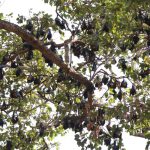By Karyn Simpson
Medill Reports
SIEM REAP, Cambodia — Passersby usually look at the camera first.
Propped lens-up on an upside-down, red laundry basket in the middle of the street, the setup understandably draws attention. Inevitably, their eyes follow the camera’s angle upward, tilting their heads back to squint at the leaves – or what they think are leaves – rustling on the branches above.
Their eyes widen when they realize that the biggest leaves are actually bats. But recent, preliminary research by The School for Field Studies in Siem Reap, Cambodia, suggests that these bats might be as unsettled by us as we are by them.
“The big picture here is studying the ability of species to adapt to their urban environments,” said Colin Meenk, a student at The School for Field Studies this past summer and a rising senior from Whitman College in Washington. The small picture, though, is examining how much stress people – and our ever-present noise – are causing Cambodia’s already vulnerable population of flying foxes.
“My project studies the Pteropus Lylei population, which is Lyles Flying Fox – bats,” Meenk said. “It is assessing anthropogenic stressors on them, such as noise, number of people, etc., and also other independent variables such as temperature and weather conditions. All four variables of which may influence their stress.”
But why are stressed-out bats something to be concerned about? Because this particular species of flying fox is listed as “vulnerable” on the red list of the International Union for the Conservation of Nature , said Megan English, Ph.D., a resident lecturer in conservation science at the School for Field Studies. She is the primary investigator on this project. And because stress could affect the bats’ ability to adapt to their changing urban environment, Meenk said. With only a few populations throughout Vietnam, Cambodia and Thailand, Lyle’s Flying Fox numbers have been steadily declining since 1996, according to IUCN’s website.
Though bats are the focus of this study, the issue is bigger than just these flying foxes. Concern for species across the globe is rising as urbanization and development continue to encroach on species’ habitats.
“I think every animal is important to understand and study, [but] particularly animals that are vulnerable to extinction because they happen to be inhabiting an area where we are such a huge influence, potentially, on them,” English said. “I think it’s up to us to try and mitigate [impacts] and try and do what we can to understand them and try to reduce them from going from vulnerable to endangered.”
Meenk spent the semester at the School for Field Studies in Cambodia, a study abroad program that culminates in a month-long directed research project. For these projects, students, under the tutelage of an SFS professor, conduct primary environmental research in Cambodia. Meenk’s study grew from short-term research done by a student at The School for Field Studies in 2018, which also looked at the influence of noise on bat stress, English said. While the previous study did find some correlation between human activity and bat stress behavior, The School for Field Studies wanted to do more in-depth research that collected a larger data set in order to paint a more complete picture of both potential stressors and how the bats are reacting.
So Meenk watches the bats for signs of stress. While bats can’t sigh and explain their feelings like a human, they perform other small movements such as scratching and hanging tense that previous researchers have identified as stress-related. By propping the camera lens-up on the upturned laundry basket in the middle of the street, Meenk was able to record these bat movements while simultaneously taking other data readings such as noise level, number of people in the area and temperature at two-minute intervals.
This recording process wasn’t as simple as it sounds, though. The regularly triple-digit temperatures meant the camera had a habit of overheating and simply refusing to function – a temper tantrum that was initially resolved by bringing a chair to block direct sunlight, but when that failed, evolved into assigning a person (usually English, another SFS faculty member, or – in a pinch – yours truly) to stand so that their shadow fell across the camera.
Though somewhat difficult, recording the movement in order to analyze stress behaviors was crucial to Meenk’s final analysis, which found significant correlation between noise level, number of people in the area and bat stress behaviors.
Simply put, the bats showed more stress when the Royal Gardens filled with people – and noise. Surprisingly, though, the bats didn’t show the same level of stress that the camera did to the heat, as Meenk found no significant correlation between temperature or weather and stress behaviors.
“The bats displayed more behavioral stress when noise recordings were at a high decibel, and similarly, when there were more people present within the vicinity,” Meenk wrote in his research analysis.
To come to this conclusion, Meenk analyzed the recordings at two-minute intervals – the same two-minute intervals at which he took noise readings and counted people in the area. In those intervals, he found 473 stress-related behaviors, which included motions such as “hang tense,” “scratch,” and “turn.” These are defined as daytime bat stress behaviors in “Behaviour of the Black Flying Fox Pteropus alecto: 1. An Ethogram of Behaviour, and Preliminary Characterisation of Mother-Infant Interactions,” a 2002 paper by Nicola Markus and Judith K. Blackshaw. Meenk disregarded instances of wing fanning, though listed as a stress-related behavior, because the excessive heat could have meant the bats were fanning to keep themselves cool, as opposed to because they were stressed, Meenk said.
Because the Royal Gardens are a commercial area, Cambodia’s noise pollution decree limits noise to a maximum of 70 decibels – the level of noise you might experience from running a vacuum cleaner or standing near a freeway. But the actual noise levels in the Royal Gardens, beneath the bats’ trees, exceeded this limit more than 25 percent of the time, according to Meenk’s research. While some of this excessive noise might be attributed to Siem Reap’s annual Khmer New Year celebration, which – for the first time – took place in the Royal Gardens beneath the very trees these bats call home, the high noise levels continued throughout the rest of the data collection period.
This means that the bats are living with high, rapidly changing noise levels for much of their daily life – a conclusion that is important to note because this noise appears to be causing the bats some level of stress, Meenk said, which could then impact their ability to adjust to the constant changes that are common in a continually developing urban environment like Siem Reap. And if the bats have trouble adapting to the urban changes, then their population levels could drop even further.
This isn’t just unique to Siem Reap’s flying fox population, though. Animals living in and around cities across the globe are having to adapt to developing urban environments, and understanding exactly what stressors species are confronting and how they react is the first step in understanding how to shape urban development in those areas.
“As we know, people moving from rural environments to urban centers is increasing rapidly,” English said. “And I think it’s important to understand, whether it’s plant species, animal species, how they’re actually coping with this rapid growth, and try and mitigate and figure out ways in which we can protect them, or that we can coexist without having a negative impact on them.”
There’s no current research on how the stressors Meenk recorded will affect the bats over time, English said. While the bats could adapt to the stressors in their habitat, the population may also begin to experience detrimental effects as stress levels increase.
“There’s little very known about the impacts of urbanization on these species that occupy these particular niches in an urban environment,” English said. “Potentially, one outcome could be, the bats or other animals, they become habituated. They get used to the noise, they get used to the disturbance, and they’re able to adapt and survive, and they might be fine. But over time, you may notice it actually has a negative impact on them – like stress behavior may increase, mortalities may increase.”
This was student research, meaning it hasn’t been peer-reviewed and needs to be replicated across different seasons and longer-term studies. It was conducted with permission from the General Directorate of Environmental Protection and the Department of Air Quality and Noise within the Ministry of Environment, and English hopes to continue this research through The School for Field Studies in the future.
By examining stressors and stress behaviors throughout different times of year and continuing to contribute data points to a larger data set, researchers can hopefully continue to build a more comprehensive picture of how people are affecting this vulnerable population and, eventually, what can change to allow both humans and bats to coexist without causing unnecessary stress.
“If other groups are interested in conserving bats in urban environments, then they would want to know the most significant factors affecting their existence,” Meenk said. “This demonstrates that people and noise are significant factors, or at least helps to demonstrate.”
They hope that this data, too, can encourage other researchers to look at urbanization and species adaptability on a wider scale – not just Lyle’s Flying Foxes in Siem Reap, but species across the globe that are becoming more vulnerable as they are forced to adapt to an environment that includes people and all the commotion and development we bring with us.
“Urbanization is exponentially increasing on a global scale, and that is taking out a lot of natural areas, natural habitats,” Meenk said. “If we want to conserve species, then we need to look at the other ways in which they are adapting.”




(Karyn Simpson/MEDILL)


